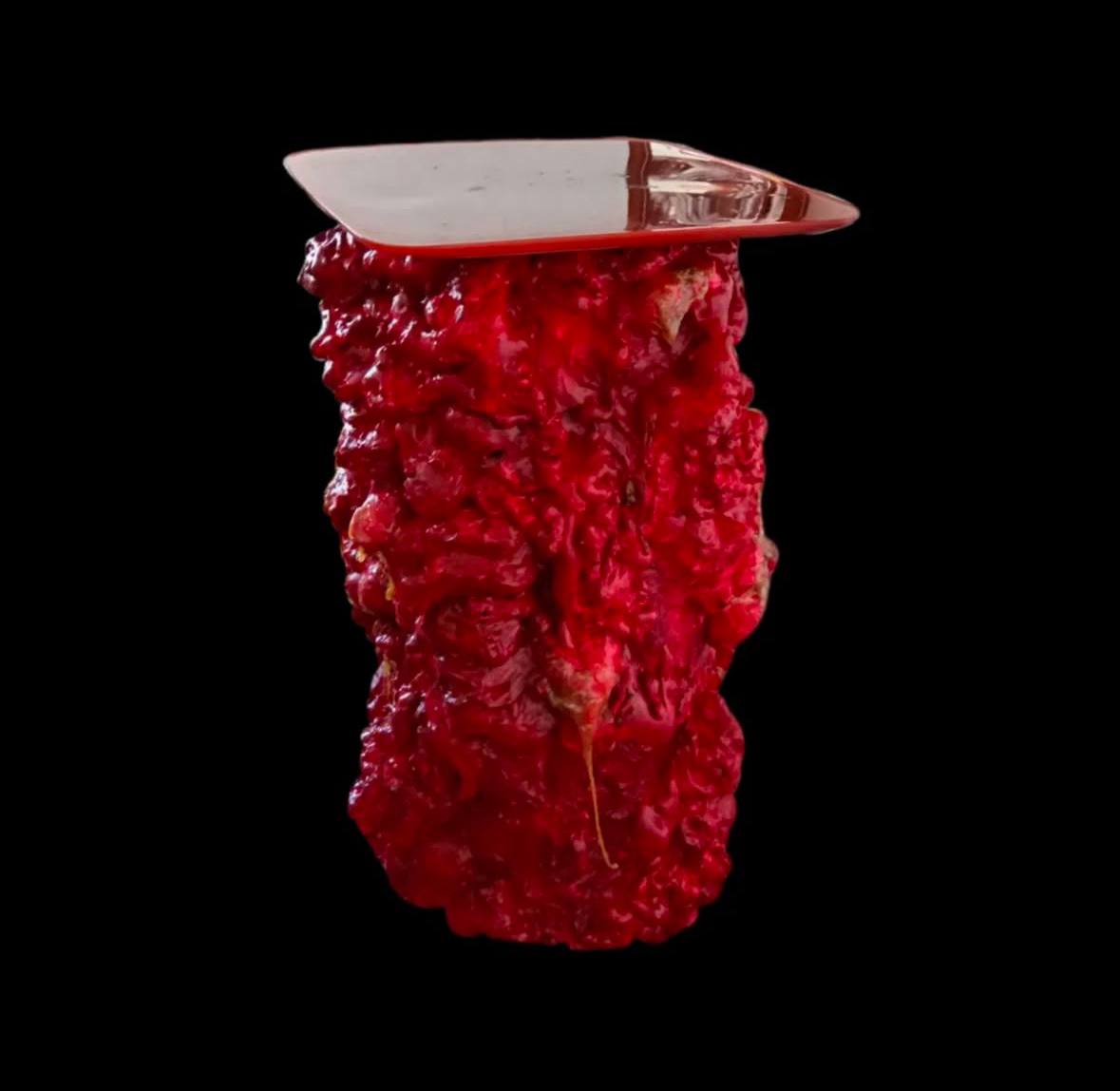/ ESP
QUE IMPORTANCIA TIENEN LOS RITUALES PROPIOS QUE SE HACEN A OSCURAS DE LOS DEMÁS
2023
Resinas orgánicas, resina epoxy, espuma de poliuretano
100 cm x 50 cm
La condición de mueble que se suele atribuir a la mesa, cuando también se utiliza como refugio, como hogar. No sólo como soporte o base para poner otras cosas, sino para aprovechar la parte inferior, el espacio vacío del objeto.
La morfología de la mesa se desvanece y se elimina el contenido cultural relacionado con el propio objeto.
La definición, por ejemplo, de lo que es una mesa, queda entonces suprimida cuando un animal o un niño se esconde debajo de ella en busca de refugio. Y la mesa deja de ser un objeto en el que sólo se utiliza su parte superior. Deja de ser un objeto y se convierte en un lugar. Un espacio que está habitado.
Si una mesa se coloca a la altura de nuestras manos, es, en efecto, un tablero, que culturalmente se define como mesa. Si se coloca encima de nosotros, conservando la misma estructura, entonces se convierte en un techo. Y por tanto, el contenido extrasomático que está vinculado al objeto desaparece. La vulnerabilidad de lo que significa buscar seguridad en un espacio en el que nos permitimos sentirnos
pequeños.
Visualmente, esta pieza puede recordar a órganos, fluidos, una corporalidad que parece crecer y expandirse. Elementos orgánicos y casi viscerales como símil de crecimiento, un crecimiento a la vez literal y emocional.
QUE IMPORTANCIA TIENEN LOS RITUALES PROPIOS QUE SE HACEN A OSCURAS DE LOS DEMÁS
2023
Resinas orgánicas, resina epoxy, espuma de poliuretano
100 cm x 50 cm
La condición de mueble que se suele atribuir a la mesa, cuando también se utiliza como refugio, como hogar. No sólo como soporte o base para poner otras cosas, sino para aprovechar la parte inferior, el espacio vacío del objeto.
La morfología de la mesa se desvanece y se elimina el contenido cultural relacionado con el propio objeto.
La definición, por ejemplo, de lo que es una mesa, queda entonces suprimida cuando un animal o un niño se esconde debajo de ella en busca de refugio. Y la mesa deja de ser un objeto en el que sólo se utiliza su parte superior. Deja de ser un objeto y se convierte en un lugar. Un espacio que está habitado.
Si una mesa se coloca a la altura de nuestras manos, es, en efecto, un tablero, que culturalmente se define como mesa. Si se coloca encima de nosotros, conservando la misma estructura, entonces se convierte en un techo. Y por tanto, el contenido extrasomático que está vinculado al objeto desaparece. La vulnerabilidad de lo que significa buscar seguridad en un espacio en el que nos permitimos sentirnos
pequeños.
Visualmente, esta pieza puede recordar a órganos, fluidos, una corporalidad que parece crecer y expandirse. Elementos orgánicos y casi viscerales como símil de crecimiento, un crecimiento a la vez literal y emocional.






/ ENG
WHAT IS THE IMPORTANCE OF THE PERSONAL RITUALS PERFORMED IN THE DARK, AWAY FROM OTHERS?
2023
Organic resin, epoxy resin, polyurethane foam
100 cm x 50 cm
The condition of furniture that is usually attributed to the table, when it is also used as a refuge, a home. Not only as a support or base to put other things on, but to use the lower part, the empty space of the object.
The morphology of the table fades away and the cultural content related to the object itself is eliminated.
The definition, for example, of what a table is, is then suppressed when an animal or a child hides under it in search of shelter. And the table stops being an object in which only its upper part is used. It stops being an object and becomes a place. A space that is inhabited.
If a table is placed at the height of our hands, it is, in effect, a board, which is culturally defined as a table. If it is placed above us, preserving the same structure, then it becomes a roof. And therefore, the extrasomatic content that is linked to the object disappears. The vulnerability of what it means to seek security in a space in which we allow ourselves to feel small.
Visually, this piece can be reminiscent of organs, fluids, a corporeality that seems to grow and expand.
Organic and almost visceral elements as a simile of growth, a growth that is both literal and emotional.
![]()
![]()
![]()
WHAT IS THE IMPORTANCE OF THE PERSONAL RITUALS PERFORMED IN THE DARK, AWAY FROM OTHERS?
2023
Organic resin, epoxy resin, polyurethane foam
100 cm x 50 cm
The condition of furniture that is usually attributed to the table, when it is also used as a refuge, a home. Not only as a support or base to put other things on, but to use the lower part, the empty space of the object.
The morphology of the table fades away and the cultural content related to the object itself is eliminated.
The definition, for example, of what a table is, is then suppressed when an animal or a child hides under it in search of shelter. And the table stops being an object in which only its upper part is used. It stops being an object and becomes a place. A space that is inhabited.
If a table is placed at the height of our hands, it is, in effect, a board, which is culturally defined as a table. If it is placed above us, preserving the same structure, then it becomes a roof. And therefore, the extrasomatic content that is linked to the object disappears. The vulnerability of what it means to seek security in a space in which we allow ourselves to feel small.
Visually, this piece can be reminiscent of organs, fluids, a corporeality that seems to grow and expand.
Organic and almost visceral elements as a simile of growth, a growth that is both literal and emotional.


